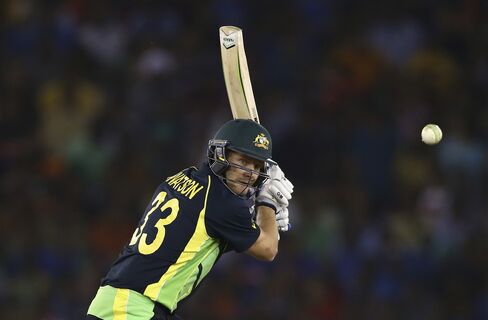A Cricket Tournament That's in a Financial League of its Own
- ndian Premier League sports a $3.5 billion business valuation
- Top players can cost $1 million-plus in pre-season auctionsShare on Facebook
Many of the world’s top cricketers will gather in India next month to compete in a league that didn’t exist 10 years ago, yet now contributes billions of rupees to the country’s economy.
The VIVO Indian Premier League 2016 features eight franchise teams representing cities across the country competing in 60 matches in the explosive Twenty20 short-duration version of the game. The IPL follows on from the ICC World Twenty20, a competition featuring national teams that is currently approaching its climax in India.
Though the IPL season lasts only a few weeks -- this year’s tournament runs from April 9 to May 29 -- the top-level international players taking part are lavishly rewarded. At February’s player auction, Australian Shane Watson attracted the highest bid, $1.4 million, to play for the Royal Challengers Bangalore team this year.

Shane Watson
Photographer: Ryan Pierse/Getty Images
The players are not the only ones to benefit. A report on the economic impact of last year’s IPL season produced by KPMG Sports Advisory Services found that the event contributed 11.5 billion rupees ($172 million) to India’s GDP. Another report, by the American Appraisal valuation services company, last year put the overall value of the IPL as a business at $3.5 billion, up 9 percent from 2014.
Multiplier
The authors of the KPMG study used an input-output model, a method that takes into account the links between the different parts of an economy. Input-output models involve the use of economic multipliers, factors that determine the total amount of spending generated by an injection of money. Their use is based on the idea that increased spending has knock-on effects that result in even greater total spending.
The direct economic impact of the IPL season, including spending on travel, accommodation, food and beverages, team outfits and equipment, promotional activities and the cost of staging matches, was put at 5.7 billion rupees.
The total output impact -- once the multiplier effect of this spending across the Indian economy was taken into account -- was 26.5 billion rupees. The report says three groups drove the economic impact of the competition -- spectators, the franchises and the organizers.
"Direct impact creates demand in the supply chain of businesses that are directly engaged with stakeholder groups," says the report, which was commissioned by the Board of Control for Cricket in India, the governing body that runs the league. "Indirect and induced impacts thus appear as knock-on effects within the economy. The total economic output impact could be expressed as the sum of direct impacts and ripple effects."
Benefits
"There are plenty of benefits to many industries," Prabhudev Konana, a professor at the University of Texas who has written about the IPL, said in an email. "These include the hospitality, media, garment -- from branded T-shirts, et cetera -- sectors and some security and cleaning services. State governments benefit from sales tax revenues that help sustain investments to improve education or infrastructure."
However, he said there were downsides such as increases in traffic congestion and pollution, disruption of day-to-day life in busy cities and security concerns.
Until recently, top-level cricket was played at a more leisurely pace, such as five-day so-called international "Test" matches.
This style of play requires batsmen with patience and a mastery of defensive shots. International matches lasting a single day began in 1971, and the first Twenty20 fixture was played in 2003.
Get Rich
Twenty20 matches typically last little more than three hours and entertain spectators with big-hitting thrills and rapid scoring. The first IPL season took place in 2008, and the competition was an immediate hit in a country that is crazy about cricket. Broadcasting and sponsorship cash poured in, confirming India’s status as the game’s financial powerhouse.
"The IPL has skewed the way domestic cricket is valued in India," according to Lawrence Booth, the editor of Wisden Cricketers’ Almanack, an annual publication that has been chronicling the game since 1864 and is known as the bible of cricket. "Before the IPL, if you were a young Indian cricketer your ambition would probably be to play Test cricket for India. Now with Twenty20, that’s where the money is and you’d think as a young player, ‘my ambition is to get very rich very quickly so I’m going to practice all the shots that will make me a Twenty20 star’," he said in a phone interview.
The success of the IPL spawned similar tournaments in other countries, and this has changed the global game. Booth gave as an example players from the West Indies, a team whose ferocious bowlers and brilliant batsmen once dominated Test cricket. Today, many of the best players from the Caribbean prefer to play Twenty20 for big money rather than represent West Indies, and the international team has been greatly weakened as a result.
"They’re putting cash before country," said Booth.
"They’re putting cash before country," said Booth.
Scandals
The IPL has been dogged by controversy -- top teams Chennai Super Kings and Rajasthan Royals were last year suspended for two years following an illegal betting and match-fixing scandal.
"The IPL seems to overcome corruption scandals, they move on and put everything behind them," said Booth. "The players consider it the number one Twenty20 tournament in the world, the money seems endless and the fans just lap it up."
Some think, however, that the league could do more to share its wealth. "It is disappointing that the IPL does not pay attention to helping local communities," said Konana from the University of Texas. "In the U.S., the National Basketball Association and the National Football League contribute massively to the local community and support numerous initiatives. I don’t see much from the IPL."
Comments
Post a Comment
thank you :)